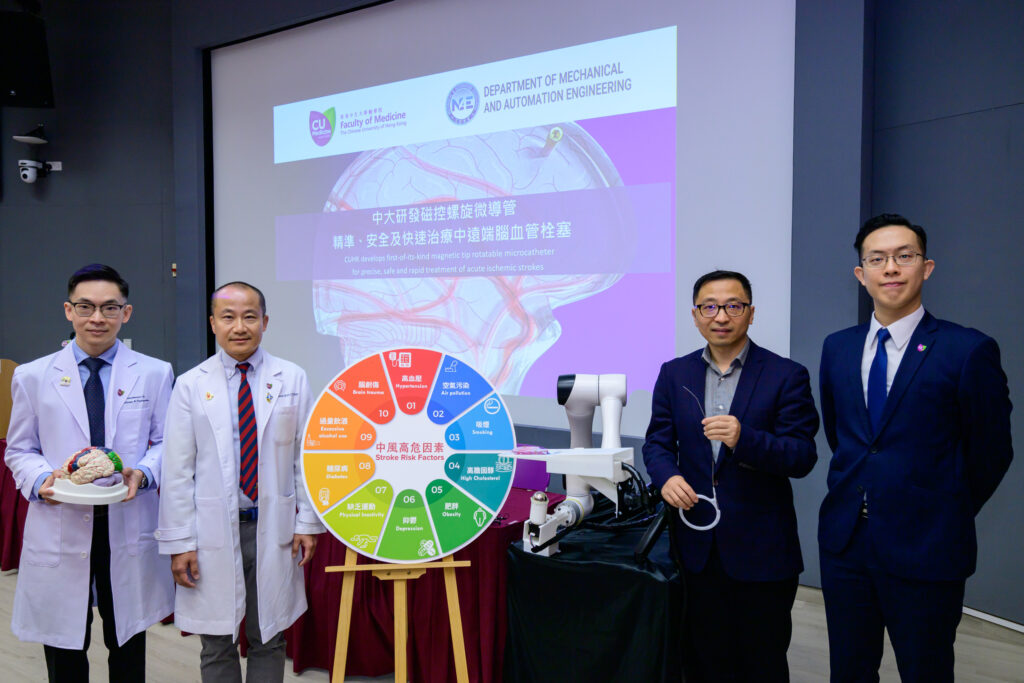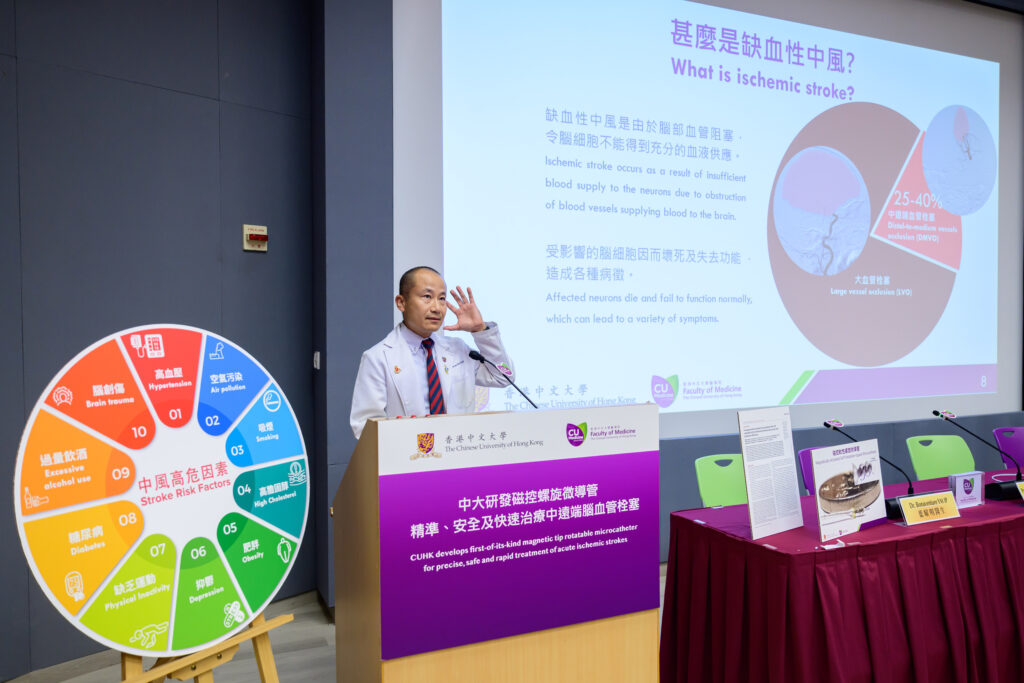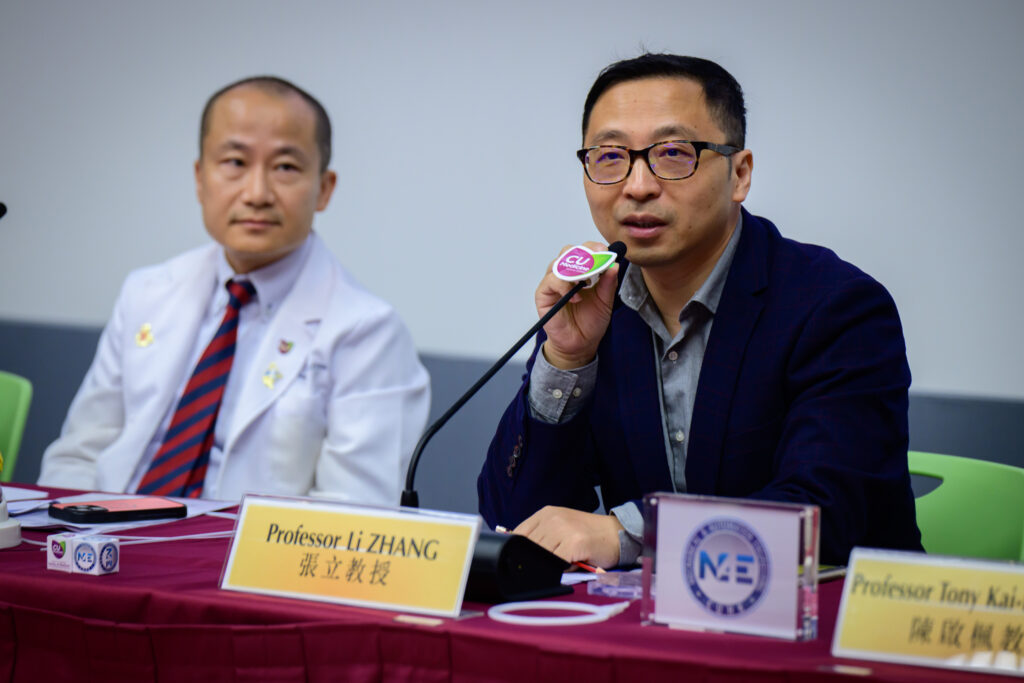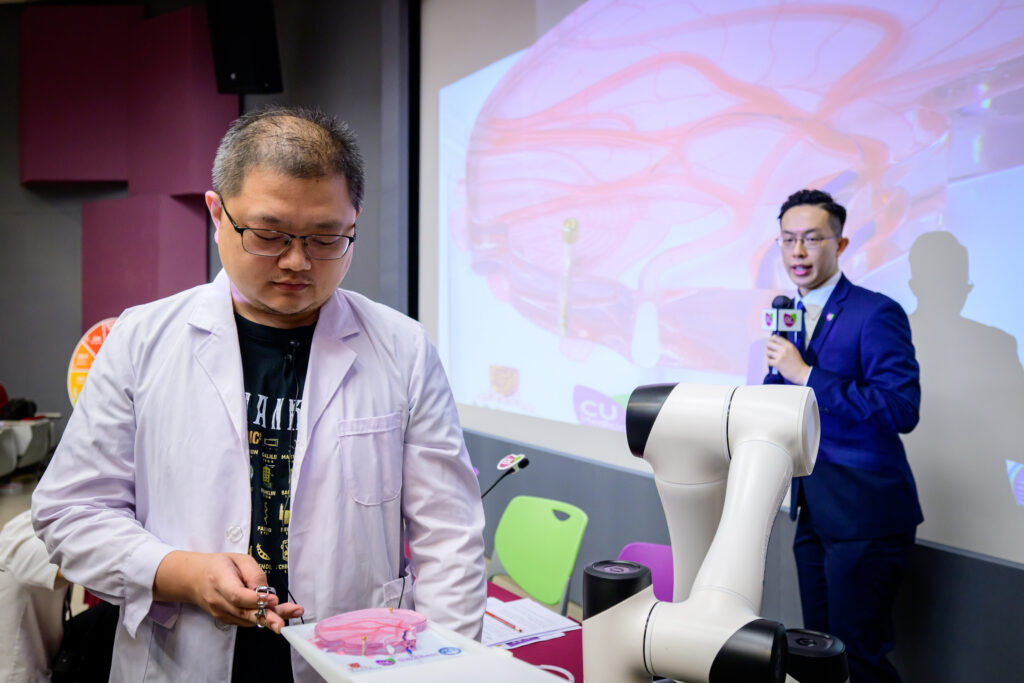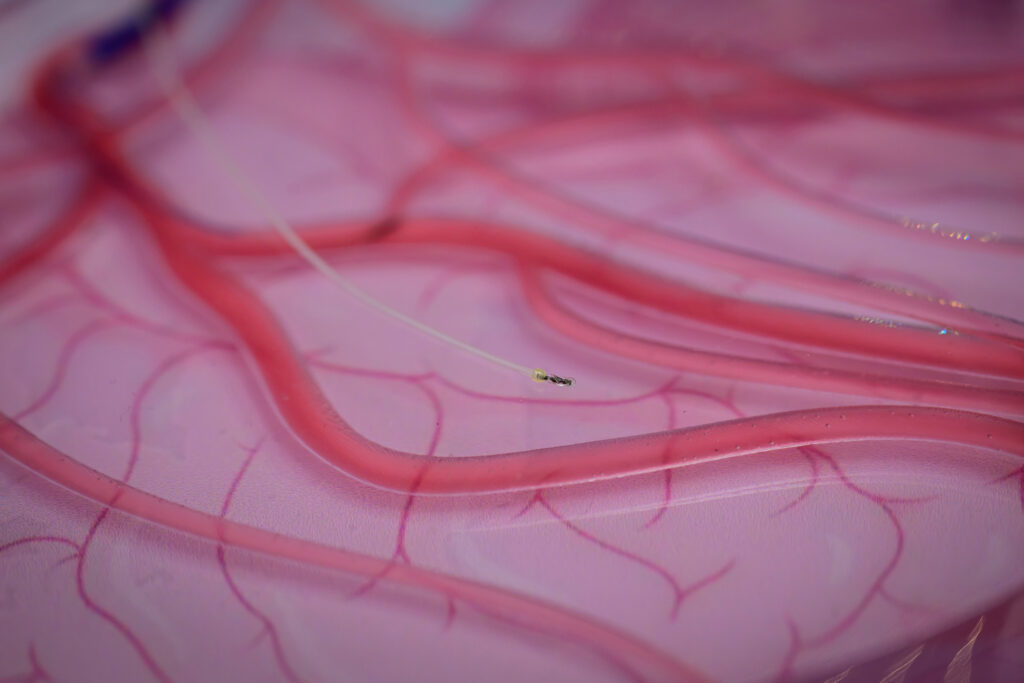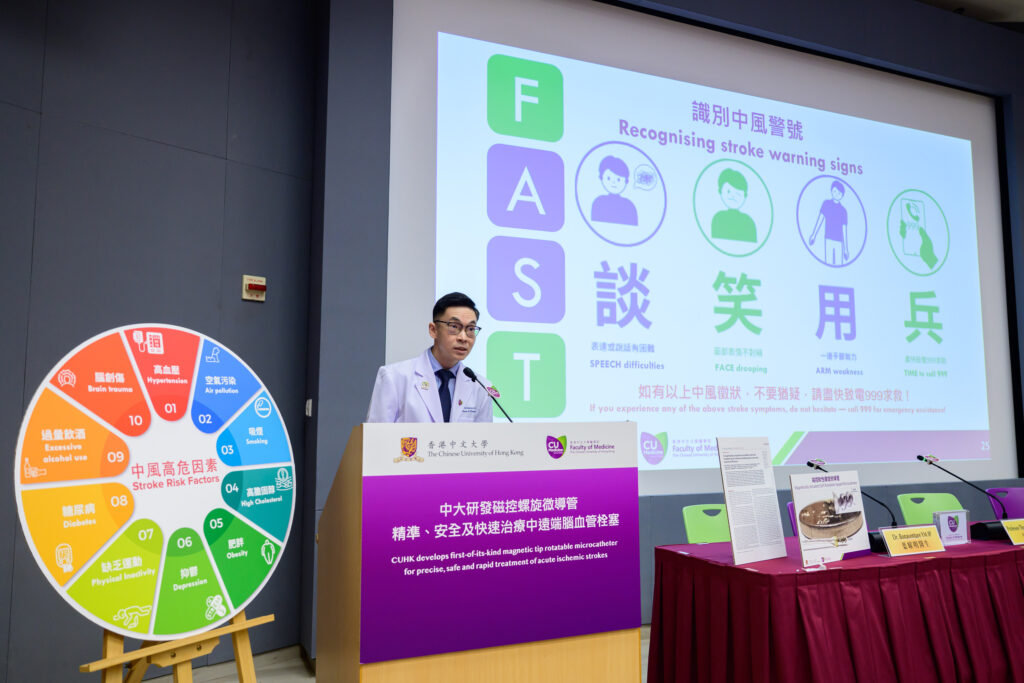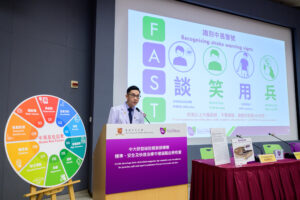CUHK
News Centre
CUHK develops first-of-its-kind magnetic tip rotatable microcatheter for precise, safe and rapid treatment of acute ischemic strokes
A cross-disciplinary research team from The Chinese University of Hong Kong (CUHK)’s Faculty of Medicine and Faculty of Engineering has developed a first-of-its-kind sub-millimeter Magnetically Actuated Soft Rotatable-tipped Microcatheter (MSRM) for targeted endovascular interventions. The novel technology demonstrates potential to provide a faster, safer, and more precise solution for treating life-threatening blood vessel blockages in the brain, addressing longstanding limitations of conventional tools in stroke intervention. Study results have been published in the international journal Science Advances.
As 22 July marks World Brain Day, the research team calls on the public to strictly manage stroke risk factors and adopt healthy lifestyles as stroke, regardless of whether the vessel occlusion is in the large or the distal-to-medium vessels (DMVO), may result in severe disability or death if not treated promptly and effectively.
Advancing stroke treatment with precision and speed
Stroke remains a leading cause of death and long-term disability worldwide. Research shows that every minute saved between stroke onset and treatment can translate into an extra week of healthy life, making rapid intervention critical. DMVOs are estimated to account for 25% to 40% of acute ischemic strokes. However, current treatment options, such as intravenous thrombolysis and mechanical thrombectomy, have limited effectiveness for these smaller, more distal vessels due to procedural risks and difficulty in achieving full reperfusion.
Stroke intervention requires arterial access, typically through a limb, followed by the navigation of guidewires and catheters through the cerebral vasculature. The interventionalist manipulates these devices externally by rotating the guidewire, but the passive transmission of rotational force through narrow, tortuous vessels often leads to slow and imprecise device control, which can compromise patient outcomes. Furthermore, the single-function design of current devices necessitates frequent tool exchanges, increasing the risk of losing distal vascular access during the procedure. Additionally, the limited ability of guidewires and catheters to negotiate sharp turns in complex vascular anatomy raises the risk of vessel wall injury, potentially resulting in cerebral hemorrhage or dissection.
The MSRM: a soft, steerable, all-in-one solution
To address these challenges, a research team with members from the Department of Medicine and Therapeutics at CU Medicine, and the Department of Mechanical and Automation Engineering at the Faculty of Engineering jointly developed the MSRM, a submillimeter-sized (0.5 mm to 0.9 mm), soft-tipped microcatheter, designed specifically for navigating complex vascular pathways and performing multiple treatment functions in one go.
Professor Zhang Li from the Department of Mechanical and Automation Engineering at the Faculty of Engineering explained: “The MSRM features a soft, rotatable tip that can be guided wirelessly using external magnetic fields, which enables precise navigation through complex blood vessels. Once it reaches the blockage, the MSRM can directly deliver clot-dissolving drugs, mechanically break down the clots, and safely retrieve clot debris. This all-in-one design eliminates the need for tool exchanges, reduces procedural risks, and significantly enhances treatment efficiency.”
Professor Thomas Leung Wai-hong, Lee Quo Wei Professor of Neurology and Head of the Division of Neurology in the Department of Medicine and Therapeutics at CU Medicine, added: “Unlike conventional tools, the MSRM’s soft silicone-based tip and low rotation speed (2–8 Hz) minimise trauma to delicate brain vessels. In tests using human placenta blood vessels, which closely resemble cerebral arteries, the MSRM showed minimal cell damage compared to the notable vessel wall damage caused by traditional guidewires. This novel device addresses key limitations in current stroke interventions and offers hope for better stroke treatment.”
Professor Tony Chan Kai-fung, Research Assistant Professor of the Chow Yuk Ho Technology Centre for Innovative Medicine at CU Medicine, commented: “The MSRM has been successfully validated in both in vivo rabbit models and ex vivo human placenta vessels, showing strong potential for future clinical application. The team envisions that this invention offers new hope for DMVO stroke patients, for whom current clot-busting procedures have not proven beneficial, partly due to the risk of complications.”
Early stroke intervention and prevention remain the key
Alongside this technological breakthrough, the team emphasizes that stroke prevention and early intervention are equally vital. Risk factors such as hypertension, smoking, physical inactivity, obesity, high cholesterol, and diabetes significantly increase the likelihood of stroke. The team urges the public to adopt a balanced diet, exercise regularly, avoid tobacco and excessive alcohol, and manage chronic health conditions through routine medical check-ups.
Dr Bonaventure Ip Yiu-ming, Assistant Professor in the Department of Medicine and Therapeutics at CU Medicine, remarked: “Recognising stroke warning signs is just as important. If a stroke is suspected, it is vital to act without delay and seek urgent medical attention. Timely intervention can save lives and significantly reduce the risk of long-term disability.”
The full research article can be accessed here:
Science Advances: http://bit.ly/4k6JOJs
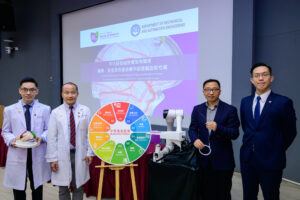
Featured are the cross interdisciplinary team including (from left) Dr Bonaventure Ip Yiu-ming, Assistant Professor; Professor Thomas Leung Wai-hong, Lee Quo Wei Professor of Neurology and Head of the Division of Neurology, both from the Department of Medicine and Therapeutics at CU Medicine; Professor Zhang Li from the Department of Mechanical and Automation Engineering at the Faculty of Engineering; as well as Professor Tony Chan Kai-fung, Research Assistant Professor of the Chow Yuk Ho Technology Centre for Innovative Medicine at CU Medicine.
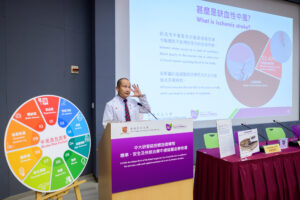
Professor Thomas Leung highlights that the cerebral vasculature resembles a maze and the risks of losing distal vascular access are high during a procedure. As every minute saved between stroke onset and treatment can translate into an extra disability-free life expectancy, precise and safe navigation can help doctors capture the golden window for life-saving intervention.
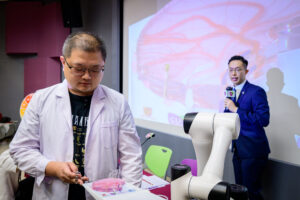
(First from left) Dr Zhang Moqiu, the first author of the study and a post-doctoral fellow from the Department of Mechanical and Automation Engineering at the Faculty of Engineering; and Professor Tony Chan demonstrate how the Magnetically Actuated Soft Rotatable-tipped Microcatheter (MSRM) navigates the complex cerebral vasculature, which causes minimal damage to fragile blood vessels.
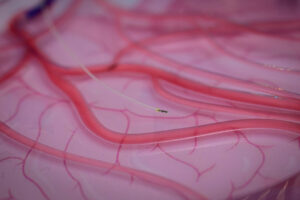
Unlike single-function traditional guidewires and catheters, the tip of MSRM is soft silicone-based and magnetically rotatable. With both navigation and therapeutic functions, it is expected to enable more precise, safer and faster interventional treatment for patients suffering from blood vessel blockages in the brain.


